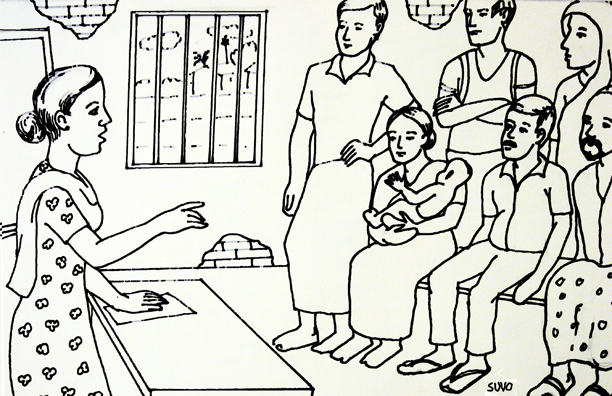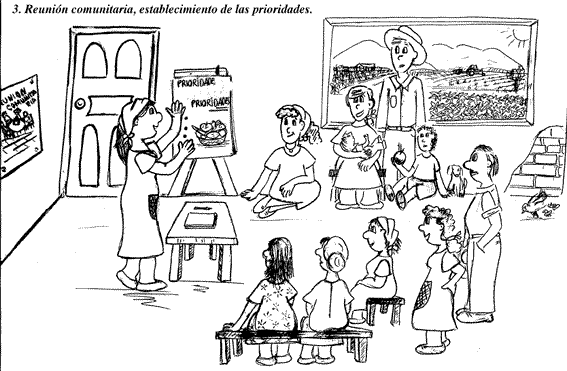
|
Work in progress, expect frequent changes. Help and feedback is welcome. See discussion page.
|

|
This first half of the course looks at community empowerment from the point of view of the community. How does a community become more empowered? It complements the second half of the course which shows what the mobiliser must do to stimulate this process of empowerment.
Outcomes
- The student will become aware of community empowerment as a social process.
- The student will be able to identify what contributes to the empowerment process
- The student will be able to identify the eight elements of the empowerment methodology, the six dimensions of culture, the sixteen elements of strength, and how each of these contributes to the process
|
Introduction to the Empowerment Methodology
Outcomes
- The student will become familiar with the essential aspects of the Empowerment Methodology: eight empowerment principles, six dimensions and sixteen elements of strength
- The student will become prepared for learning the main details of the empowerment methodology
|

Avoiding Social Engineering
Outcomes
- The student will be introduced to the concept of social engineering as forced social change where the participants do not make the choices to change
- The student will learn that we can not force a community to grow and become stronger (social engineering) but we can encourage and guide it to develop itself
- The student will be able to distinguish between capacity building (social engineering) and capacity development where the participants take responsibility for their own strengthening.
|
Outcomes
- The student will be able to explain the arguments for helping communities to become empowered
- The student will be able to see that the community is the most effective institution to change for fighting the war on poverty
- The student will be able to distinguish between communities that should or should not be empowered. Similarly: could and could not
- The student will be able to see that power, capacity and ability all describe strength of a community
- The student will have tools for choosing which communities to empower
- The student will be able to distinguish between wealth and money
- The student will recognize poverty as a social problem which needs a social solution
- The student will see that participation means participating in decision making, not only contributing or being consulted
- The student will recognize that community participation is essential for success and sustaining a community project
|
Factors of Poverty (Not Causes)
Outcomes
- The student will be able to distinuish between factors and causes
- The student will recognize that fighting poverty requires addressing factors; not symptoms; not causes
- The student will recognize the role of disease as a factor of poverty
- The student will recognize the role of apathy as a factor of poverty
- The student will recognize the role of dependency as a factor of poverty
- The student will recognize the role of ignorance as a factor of poverty
- The student will recognize the role of dishonesty as a factor of poverty
|
The Problem with Charity
Outcomes
- The student will recognize the charity approach which contributes to poverty rather than counteracts it
- The student will recognise the value and dangers of seeing the dependency syndrome as like the so called "welfare mentality" which keeps people on social security assistance from seeing jobs
- The student will see that the cliche slogan "Better a hand up than a handout," has some validity in explaining the dangers of charity
- The student will see that corruption, which is encouraged by charity, causes far more to be lost by the society than is gained by the embezzler
- The student will see that the empowerment method is based more on a partnership while the charity method is based pn condescending and patronizing attitudes
|
The Dependency Syndrome
Outcomes
- The student will be able to recognize dependency in a community and in a Government, knowing that this is a factor contributing to poverty.
- The student will be able to distinguish between appropriate uses of charity, such as during an emergency response, and inappropriate uses, such as sustainable development
- The student will recognize that giving alms trains the receiver to be more of a beggar
- The student will see the pedagogical value to the broken bone analogy in the shift from emergency response (charity) to the empowerment methodology (sustainable development)
- The student will recognize that money transfers may alleviate specific cases of poverty but does not solve the social problem of poverty
- The student will know the basics of income generation (formation of new wealth)
|
Hidden Resources
Outcomes
- The student will recognize that communities have a tendency to hide their resources, and how to reveal them for empowering q community
- The student will be able to list the various reasons why people hide their wealth
- The student will be able to cite why transparency is important in revealing community resources to empower a community
- The student will be able to identify what some people call liabilities, yet can be resources for community empowerment
- The student will be able to twist newspeak or spin doctoring for beneficial purposes rather than for obfuscating governmental misdeeds.
|
The Mobilization Cycle
Outcomes
- The student will understand the mobilization intervention as a "cycle"
- The student will be able to create a mobilization cycle for any community
- The student will know how to use training as a method of mobilizing
- The student will see the danger of a single community project and be able to use the cycle approach to ensure a sustainable ongoing process
- The student will learn how records can be used to ensure the cycle is sustained
- The student will know how records can be used to make reports
|
This second half of the course describes what the the individual, the mobilizer, needs to do in order to achieve the social process described in Part A. This is a complement to Part A which describes the process from the point of view of the community.
Outcomes
- The student will Be able to work as a mobilizer in the field to empower a community
- The student will be able to coordinate or manage a team of mobilizers
- The student will be able to train new mobilizers
|
To Be a Mobiliser
Outcomes
- The student will be able to self assess to see if she or he can become a mobilizer
- The student will be able to distinguish between intrinsic and learnable characteristics of a mobilizer
- The student will recognize that reputation is the most important asset of the mobilizer
- The student will recognize that integrity is not only important in itself, but that the community members must see it in their mobilizer and in their leaders
- The student will be able to recognize communities that are not ready to be mobilized
- The student will recognize that the mobilizer must be able to walk away from communities that are not ready to be mobilized.
|
Getting Prepared
Outcomes
- The student will be able to cite the goals of mobilization for empowerment
- The student will be able to assess the nature and organization of the target communities
- The student will be able to list the skills needed to mobilize
- The student will be able to list and define the basic empowerment concepts
|
Outcomes
- The student will know how to get necessary permissions to being a mobilizer in the area
- The student will know how to raise awareness, especially among officials and leaders, without raising expectations that gifts are forthcoming
- The student will know the importance of challenging the community's first wishes, and how to convert them into do-able actions by the community
- The student will be able to guide a community in making decisions about what action it should take
|
Outcomes
- The student will know how to organize for decision making and organize for action, and be able to distinguish between them
- The student will recognize the origin and parallels or community organizing with both management training and union organizing
- The student will be able to guide the community in making a plan of action
- The student will be able to guide the community to design a community project
|
Outcomes
- The student will recognize that community action is vital for community empowerment
- The student will know how to stimulate the community to take action by implementing its plan
- The student will recognize that after the action starts the community members become more aware of the skills they need
- The student will be prepared to provide needed skills when the community recognizes their need
- The student will recognize the need for the community to monitor its own action, and will be able to encourage and guide the community to do so
- The student will recognize the need for public celebration, that it is part of the necessary work of the mobilizer. The student will learn to look up words like veisalgia
|

Sustaining the Process
Outcomes
- The student will understand the importance of sustaining the intervention beyond a single community project
- The student will see that if a community cannot maintain its facility, it might as well have not been installed
- The student will understand the need for finding community leaders to carry on, and how to identify and prepare them to do so
- The student will know how to take notes from her or his journals and prepare a handover report for the new incoming mobilizer
|
Community Empowerment and National Development (Conclusion)
Outcomes
- The student will understand the role of community empowerment in national development
- The student will understand an important factor (among several) in the failure of newly independent countries to become self reliant
- The student will understand that new rules or laws allowing community participation do not guarantee that there will be community participation (the government or alternatives must take a proactive role in stimulating and encouraging community empowerment interventions)
- The student will understand the necessity of obtaining needed resources from the right sources. (Cows do not provide eggs)
|

